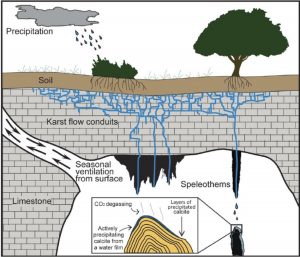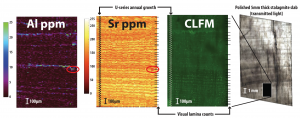Heather Gunn – Spring 2021 Honors Thesis
GSA Abstract: Central Texas caves feature slow-growth (<10-100 µm/yr) stalagmite records as old as 70 ka that span glacial and deglacial hydroclimate cycles. Monitoring efforts in these caves indicate: calcite growth occurs mainly during cold seasons when cave-air CO2 concentrations are lowered by ventilation; drip waters have interannual epikarst residence times; calcite accumulation rate follows drip rate. In moisture-limited settings such as central Texas, drip rates likely proxy the epikarst volume of recharge precipitation. Associated stalagmites may therefore preserve millennial-scale records of recharge variation as growth band thickness. To accurately reconstruct hydroclimate, resolving seasonal growth variation is key, but seasonal growth bands are often not visible by conventional petrography. Confocal laser fluorescence microscopy (CLFM) can reveal growth bands as fluorescent couplets, but this technique is time consuming and results vary. If fluorescence variations parallel elemental variations during seasonal growth, 2D chemical mapping of stalagmite growth banding by LA-ICP-MS may provide a complementary or superior approach for hydroclimate reconstructions.
To assess this hypothesis, we performed 2D chemical mapping on a well-dated central Texas stalagmite (CWN-4) across the ~14.65 ka transition from Heinrich Stadial 1 to Bølling-Allerød interstadial (HBT), a rapid deglacial warming episode. U-series constraints indicate a substantial increase in calcite accumulation rate across HBT. Elements analyzed (Mg, Al, P, Ca, Co, Ni, Cu, Zn, Sr, Y, & Ba) were selected for their associations with fluorescence, water-rock interaction, and/or prior calcite precipitation. Sr and Ba most effectively displayed stratigraphic enrichment/depletion cycles corresponding with CLFM imagery over the same map areas and are consistent with seasonal cycles driven by ventilation. The number of enrichment cycles closely correspond with predicted annual growth rates by bracketing U-series ages. The thickness of resolved growth couplets increases above HBT interval using both LA-ICP-MS and CLFM, supporting that recharge volume increased in central Texas following the HBT. These findings support that highly resolved hydroclimate reconstructions may be possible with 2D chemical mapping by LA-ICP-MS.
GSA presentation (power point)
© 2024 Jackson School of Geosciences, The University of Texas at Austin



